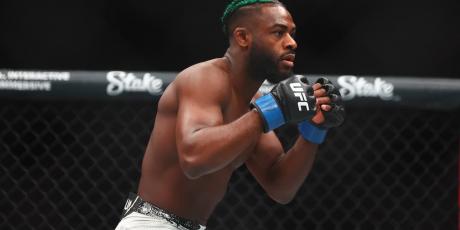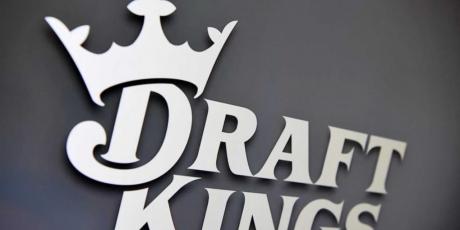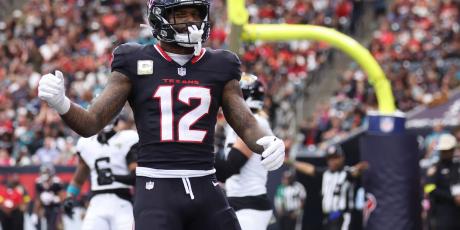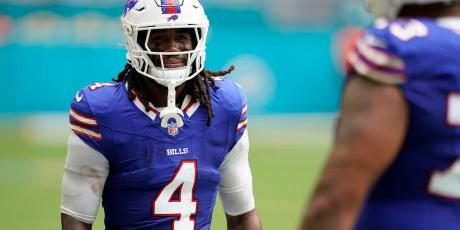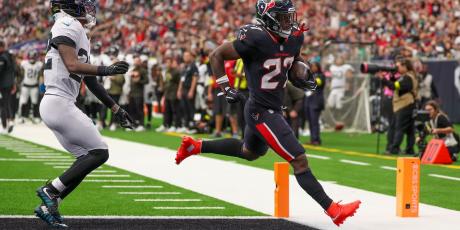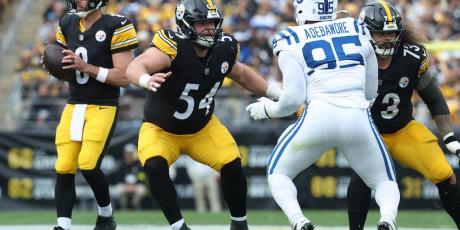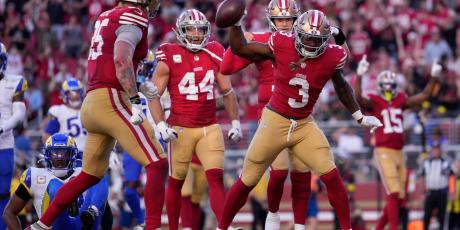BestBall10s Strategy: Roster Construction

If you’re already jonesing for fantasy football content and aren’t really into dynasty (or even if you are), best ball is starting to ramp up, and now’s the perfect time to dive into what worked and what didn’t last season, with a look at what’s to come for 2021.
For this specific piece, I’ll focus on the roster construction for Bestball10s leagues, which boast full-PPR scoring, defenses and sadly, no kickers. One of the most intriguing aspects of the best ball format is the myriad of strategies that are implemented, with no approach being fool-proof.
Roster construction is important when selecting your best ball teams, so that you can maximize all 20 rounds in terms of opportunity cost, investments and value. We’ll take a look at which builds worked best in 2020 and attempt to project what key takeaways may be applied to this upcoming season.
Roster Construction of Winning Best Ball Teams
| Rank | % of Winning Rosters | QB | RB | WR | TE | DEF |
|---|---|---|---|---|---|---|
| 1 | 11.52% | 2 | 6 | 7 | 3 | 2 |
| 2 | 9.84% | 3 | 5 | 7 | 3 | 2 |
| 3 | 9.76% | 3 | 6 | 7 | 2 | 2 |
| 4 | 9.22% | 3 | 6 | 6 | 3 | 2 |
| 5 | 7.34% | 2 | 6 | 8 | 2 | 2 |
| 6 | 6.00% | 2 | 7 | 7 | 2 | 2 |
| 7 | 4.98% | 2 | 6 | 7 | 2 | 3 |
| 8 | 4.80% | 2 | 5 | 8 | 3 | 2 |
| 9 | 4.45% | 3 | 5 | 8 | 2 | 2 |
| 10 | 3.08% | 3 | 7 | 6 | 2 | 2 |
| 11 | 2.96% | 2 | 5 | 7 | 3 | 3 |
| 12 | 2.85% | 2 | 5 | 8 | 2 | 3 |
When looking at these builds, the winning rosters used a broad-minded approach, requiring balance with a nuanced understanding of each position. In other words, with full-PPR scoring and the requirement to start three WRs, drafters leaned towards a heavy-WR build, with 10 of the top-12 constructions featuring seven or more wideouts.
However, those drafters didn’t ignore or neglect the other positions in order to juice up on WR—in fact, BestBall10 winners in 2020 drafted an RB in the first round 76.8% of the time, with Alvin Kamara, Dalvin Cook and Derrick Henry boasting the highest win rates last year. While early RB was a hot strategy, we can see that multiple builds could still be used to take down a league.
When looking at the onesie positions, we get a different outcome than data from FFPC best ball leagues, as their regular (non-slim) formats are 28 rounds as opposed to just 20 here. Of the top-12 BB10s builds, seven went with two QBs and two TEs, (not necessarily at the same time), while five of the winners were constructed with three of each (also not always together on the same build). In FFPC format, you see the highest-scoring rosters featuring three and four QBs, along with three, four and even five TEs.
Defenses, which universally get zero respect, played out with 9-of-12 winning builds drafting two team defenses, and none of them being selected before the 15th round.
Taking two at the onesie positions makes sense when there are only 20 rounds, as you want to acquire as many core players (WRs and RBs) as possible, however, you’re also assuming some risk. First, your guys actually need to make it through the season which we all know is not guaranteed, and unless one of those is a stud, you’ll need a combination of the two to consistently land among the top 12 at their position to provide an edge.
Looking at TE, it’s no surprise that the two with the highest win rates in 2020 were Travis Kelce (24.3%) and Darren Waller (14.5%), who were drafted in the second and sixth round, respectively. Rolling with two later-round players at TE is a strategy many decide to go with every year, but it is certainly a gamble in today’s NFL. Irv Smith Jr., at an ADP of 15.03, was the latest drafted at his position to make it onto winning rosters (9.0%), and it’s entirely possible he was paired with one of the early-round guys.
Last year, we saw a slew of mid-round QBs find their way onto the highest-scoring builds. The four top signal-callers who were on rosters hitting pay dirt—Josh Allen, Aaron Rodgers, Deshaun Watson, and Russell Wilson—were all drafted in Rounds 7–10, with only Patrick Mahomes as a third-rounder making the list as anything above the seventh round.
Early Rounds
| Round | QB | RB | WR | TE | DEF |
|---|---|---|---|---|---|
| 1 | 0.0% | 76.8% | 22.7% | 0.5% | 0.0% |
| 2 | 1.0% | 38.0% | 33.5% | 27.5% | 0.0% |
| 3 | 10.3% | 39.6% | 49.2% | 0.9% | 0.0% |
| 4 | 2.6% | 32.4% | 61.3% | 3.7% | 0.0% |
| 5 | 0.9% | 35.7% | 54.2% | 9.3% | 0.0% |
| 6 | 6.6% | 26.4% | 56.3% | 10.6% | 0.0% |
| 7 | 26.8% | 24.0% | 38.4% | 10.7% | 0.0% |
With opportunity cost in mind, we can grab some important takeaways from how high-scoring teams drafted last season. Choices made at the start have an impact on the entire draft, as expected fantasy output tends to decrease with each round.
Running backs—pass-catching backs in particular—were popular among winners in the first two rounds. With full-PPR scoring, we saw a higher percentage of backs drafted in the first two rounds, but a major shift towards receiving in Rounds 3-7 saw the highest percentage of wideouts taken among winners.
Circling back to winners paying up for TE in 2020, I found it interesting that 27.5% of the highest-scoring rosters in Bestball 10s drafted one in the second round (Kelce), and that number takes a nosedive until we reach 22.5% of winning rosters drafting a TE in the 10th round. So once again we see that after that elite tier of TEs, opportunity cost could lead drafters to stay with core players in those earlier rounds and guide them to wait a bit on a few gambles at the TE position since the numbers show very few winners coming from Rounds 3–7.
At QB, we see that the highest percentage of teams in the money in 2020 took a signal-caller in the seventh round. Based on last season’s ADP, we’re looking at the trio of Kyler Murray, Deshaun Watson and Russell Wilson, whose win rate at their position ranked third, fourth and sixth, respectively. It’s still crazy early, but if we look at February ADP for Bestball 10s, both Watson and Wilson are being selected in the seventh round again, along with Dak Prescott and Justin Herbert.
Middle Rounds
| Round | QB | RB | WR | TE | DEF |
|---|---|---|---|---|---|
| 8 | 16.1% | 29.9% | 40.9% | 13.1% | 0.1% |
| 9 | 19.2% | 32.0% | 32.8% | 16.0% | 0.1% |
| 10 | 22.6% | 27.7% | 27.1% | 22.5% | 0.1% |
| 11 | 24.3% | 24.4% | 24.9% | 26.0% | 0.3% |
| 12 | 23.7% | 23.7% | 31.4% | 20.4% | 0.7% |
| 13 | 23.0% | 24.0% | 34.7% | 15.5% | 2.8% |
| 14 | 20.8% | 24.3% | 31.3% | 15.3% | 8.3% |
We begin to see a more balanced approach to roster construction in these middle rounds, as drafters are investing a bit more heavily into the onesie positions while also attempting to secure solid depth at their core. Both RB and WR drop in average scoring at a similar rate, so if we mesh the two based on draft cost and projected outcomes, we can build stronger rosters that will be competitive when the season begins.
Late Rounds
| Round | QB | RB | WR | TE | DEF |
|---|---|---|---|---|---|
| 15 | 16.2% | 24.9% | 27.7% | 12.7% | 18.5% |
| 16 | 11.0% | 24.8% | 29.3% | 10.6% | 24.3% |
| 17 | 6.6% | 19.7% | 28.4% | 8.3% | 36.9% |
| 18 | 4.9% | 17.9% | 24.3% | 7.4% | 45.4% |
| 19 | 5.6% | 17.4% | 24.2% | 9.0% | 43.8% |
| 20 | 6.2% | 20.6% | 29.4% | 12.3% | 31.5% |
Both QB and TE begin to taper off as far as successful outcomes, most likely because these were either rookie dart throws that didn’t pan out, or backups drafters were hoping would win the starting job.
The percentages for WRs pick up a bit again in these later rounds, indicating that hitting on a successful wideout in the final six rounds may occur more frequently than taking a stab at a rusher there.
While people began to take defenses as early as the 13th round according to Bestball 10s ADP from September of 2020, we see that winning fantasy managers took their defenses in the 18th and 19th rounds nearly 50% of the time, with the 17th and 20th round boasting the next-highest percentages of success.
Looking Ahead to 2021
While it is still very early, with only the fantasy degenerates bellying up to the best ball bar, we can see that the love for first-round RBs is going to be a thing again this season. But should it be?
Last year saw eight backs go in the first round, with two sustaining injuries rendering them out for the majority of the season (Christian McCaffrey and Saquon Barkley), and Joe Mixon limited to just six contests. Of the five remaining first-rounders, three of them finished exactly where you’d expect an elite draft pick to end their season. Among non-QBs in PPR scoring, Alvin Kamara ended 2020 first overall, with Dalvin Cook and Derrick Henry coming in third and fourth in total PPR points among all non-QB position players.
Whether you subscribe to Zero RB, Robust RB or anything in between, you need three WRs each week for Bestball 10s scoring. There were only two wideouts taken in the first round last season, and Davante Adams came through big time as the second-highest non- QB fantasy scorer. The other, Michael Thomas, was a huge bust as he finished as WR93 in PPR points in only seven games.
The bulk of the 12 highest-scoring WRs came from Rounds 3-5 last year, with a few exceptions. Stefon Diggs obliterated his 10th-round ADP as WR3 on the season, and rookie Justin Jefferson (16th round), outperformed early expectations with the sixth-most PPR points in 2020. Both Seattle wideouts ended a bit higher than their ADPs indicated, which is somewhat surprising based on the offense’s performance as a whole, but DK Metcalf was a sixth-rounder and ended as WR7, while Tyler Lockett finished right behind him as WR8, as an eighth-round pick.
Analyzing the various ways to build best ball rosters gives us the big picture, and clears out some of the noise surrounding non-balanced builds—at the very least it sets maximum limits. Data shows that winning rosters require stability across the core positions, especially in full-PPR formats. We’ve seen that both RB and WR drop at a similar rate as the draft progresses, so when accounting for both, we can create more competitive rosters.
Bottom Line
- Seven of the top-12 highest-scoring builds boasted two QBs, while five had three signal-callers. Winners took their QB in the seventh round at the highest rate (26.8%), followed by the 11th, 24.3% of the time. Similar opportunities should be present in 2021.
- With full-PPR scoring and the requirement to start three WRs, drafters leaned towards a heavy-WR build, with 10 of the top-12 constructions featuring seven or more wideouts, a multi-year trend.
- However, those drafters didn’t dismiss the other positions in order to pound WR—in fact, BestBall10 winners in 2020 drafted an RB in the first round 76.8% of the time.
- Winners took Travis Kelce 27.5% of the time which was the highest percentage, followed by TEs in the 11th, 10th and 12th rounds, respectively. The two most successful builds in 2020 featured three TEs, but out of the top-12, seven of them drafted only two. As is the case every year, pay up for TE, or pray that one or both of your late-round guys can produce starting numbers, or you'll lose that edge.
- While taking an elite defense early may be tempting, data shows the highest-scoring teams’ defenses came from Rounds 18 and 19 last season. Also, the six most successful roster builds had two team defenses, with only three variations in the top-12 sporting three DSTs.

